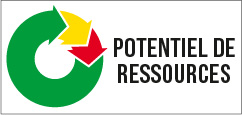As a result of this situation and the resource strategy of the European Community and its member states, SDK has developed a concept that takes the idea of resource efficiency fully into account. The concept of the resource potential certification of demanufacturing plants meets the requirements of standard DIN ISO 14024 and therefore permits transparent, verifiable, neutral and product-related evaluation of treatment, recycling and disposal plants. The use of this resource indicator puts demanufacturing plants in a position to show the actual volumes of recovered raw materials and the proportion used for energy generation and hence to reveal the potential to save primary resources.
Both the input and output flows are taken into account in the calculation in the course of resources potential certification.
For further information on resources potential certification please contact SDK through:
Frank Fellens – Phone: +352 488 216 312 – Email: frank.fellens@sdk.lu
Benefits of resource potential certification of demanufacturing plants:
• Transparent, verifiable, neutral and product-related evaluation of demanufacturing plants
• The actual volumes of recovered raw materials and the proportion used for energy generation are shown and the savings in primary resources are revealed
• Efficient calculation tool for evaluating varied treatment processes at product recipients
• Graphical display of the final output products and their value by means of colour coding
The concept of resources potential is listed as “good practice” on the website of the European Circular Economy Stakeholder Platform:
Examples of reverse production processes
(recycling/recovery/disposal) -
SDK - product recipient
Prepare for reuse:
Gas cylinders (Probutane, Propane)
IBC Plastic barrels
Toner and ink cartridges (Product Dictionary)
Recycling (material recycling):
Used oils – (Product Dictionary)
Energy saving lamps and fluorescent lamps
Extinguishers – (Product Dictionary)
Cable (copper)
Cooling liquid
Refrigerators
Plastic packaging (PP)
Plastic packaging (PS) (DVD boxes)
Oil radiators
PU foam cans – (Product Dictionary)
Packaging of dangerous substances (acid, alkali, photochemistry)
Agricultural films (silo, stretch)
Oil and Diesel-fuel filters
Kitchen oils and greases bucket
Kitchen oils and greases – (Product Dictionary)
Spray cans – (Product Dictionary)
Bumpers
Data carriers (CD, DVD)
Data carriers (vinyl records)
Automobile window panes, flat glass
Production of a substitue fuel and energy recovery
Bitumen waste and Roofing
Railroad ties
Paints, lacquers and glazes – (Product Dictionary)
Paint contaminated paper/film
Fuel
Rotary kiln – Destruction of dangerous components
Heart Pacemaker
Syringes, cannulae
Condensers
Fuel tanks (plastic)
Laboratory chemicals
Solvents – (Product Dictionary)
Oil-contaminated products
Pesticides (solid and liquid)
Photographic chemicals mixed
Acids and acid cleaners
Sandblasting waste
Hazardous substances packagings (solvents)
Spraybooth filters
Toner cartridges
Fertilizers
Paint dust
Products contaminated with paint
Grate incinerator – energetic recovery
Plastic products (big parts)
Plastic products (big parts) (composites)
Fluidised bed incinerator – energetic recovery
Composite materials (soiled)
Plastics (composites)
Plastic products PVC
Styropor (soiled)








